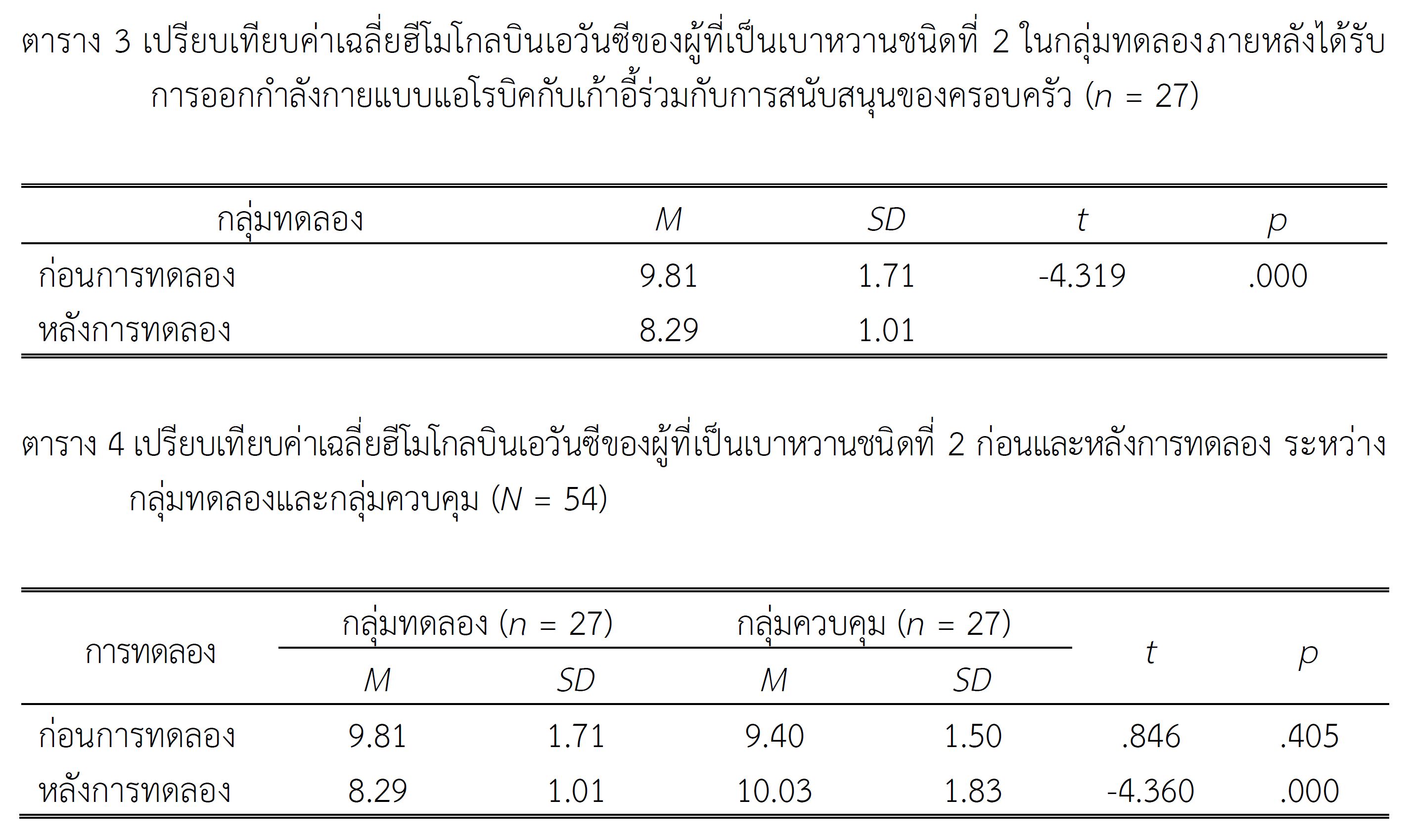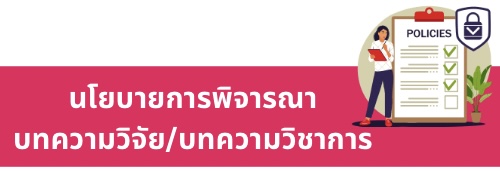ผลของการออกกำลังกายแบบแอโรบิคกับเก้าอี้ร่วมกับการสนับสนุนของครอบครัวต่อค่าฮีโมโกลบินเอวันซีในผู้ที่เป็นเบาหวานชนิดที่ 2
คำสำคัญ:
การออกกำลังกายแบบแอโรบิคกับเก้าอี้, การสนับสนุนของครอบครัว, เบาหวานชนิดที่ 2บทคัดย่อ
การวิจัยครั้งนี้เป็นการวิจัยกึ่งทดลองเพื่อศึกษาผลของการออกกำลังกายแบบแอโรบิคกับเก้าอี้ร่วมกับการสนับสนุนของครอบครัวต่อค่าฮีโมโกลบินเอวันซีในผู้ที่เป็นเบาหวานชนิดที่ 2 ตัวอย่างเป็นผู้ที่เป็นเบาหวานชนิดที่ 2 ที่มารับการรักษาที่คลินิกโรคเบาหวาน โรงพยาบาลแม่สรวย จังหวัดเชียงราย จำนวน 54 ราย แบ่งเป็นกลุ่มทดลองและกลุ่มควบคุมกลุ่มละ 27 ราย กลุ่มทดลองได้รับการส่งเสริมการออกกำลังกายแอโรบิคกับเก้าอี้ร่วมกับการสนับสนุนของครอบครัว โดยการสอนและฝึกปฏิบัติจริงและการติดตามเยี่ยมบ้าน 4 ครั้ง กลุ่มควบคุมได้รับการดูแลตามปกติ เครื่องมือการวิจัย ได้แก่ โปรแกรมการออกกำลังกายแบบแอโรบิคกับเก้าอี้ร่วมกับการสนับสนุนของครอบครัว และแบบประเมินการรับรู้การสนับสนุนของครอบครัวซึ่งมีค่าดัชนีความตรงเชิงเนื้อหาเท่ากับ .82 และค่าความเชื่อมมั่นจากหาค่าสัมประสิทธิ์แอลฟาของครอนบาคเท่ากับ .97 วิเคราะห์ข้อมูลโดยใช้สถิติเชิงพรรณนาและการทดสอบที
ผลการศึกษาพบว่า กลุ่มทดลองหลังได้รับโปรแกรมการออกกำลังกายแบบแอโรบิคกับเก้าอี้ร่วมกับการสนับสนุนของครอบครัว มีค่าเฉลี่ยฮีโมโกลบินเอวันซีต่ำกว่าก่อนการทดลอง และมีค่าเฉลี่ยฮีโมโกลบินเอวันซีลดลงมากกว่ากลุ่มควบคุมอย่างมีนัยสำคัญทางสถิติ (p < .05)
ผลการศึกษาครั้งนี้แสดงให้เห็นว่า โปรแกรมการออกกำลังกายแบบแอโรบิคกับเก้าอี้ร่วมกับการสนับสนุนของครอบครัวสามารถนำไปเป็นแนวทางในการควบคุมระดับน้ำตาลในเลือดในผู้ที่เป็นเบาหวานชนิดที่ 2 ได้
Downloads
เอกสารอ้างอิง
American College of Sports Medicine. (2006). ACSM’s Guidelines for exercise testing and prescription (7th ed.). Lippincott Williams & Wilkins, Philadelphia.
American Diabetes Association (ADA). (2018). Economic costs of diabetes in the U.S. in 2017. Diabetes Care, 41, 917-928.
American Diabetes Association (ADA). (2023). Standard of care in diabetes-2023. Diabetes Care, 46(suppl 1). s1-s291.
Andriyanto, A., Rofi’ah, I., Bahtiar, B., Wicaksono, A., Zakiyah, A., Yulianti, I., & Merbawani, R. (2022). The effectiveness of social support management of diabetes on glucose control of type 2 diabetes mellitus patients: Quasi-experiments. Journal of Medical Sciences, 10(G), 223-227.
Burn, N., & Grove, K. (2009). The practice of nursing research: conduct, critique, & utilization (6th ed). Elsevier.
Chan, C. K., Cockshaw, W., Amith, K., Truscott, E. H., Pouwer, F., & Speight, J. (2020). Social support and self-care outcomes in adults with diabetes: The mediating effects of self-efficacy and diabetes distress. Results of the second diabetes MILES - Australia (MILES-2) study. Diabetes Research Clinical Practice, 166, 108314. https://doi.org/10.1016/j.diabres.2020.108314
Diabetes Association of Thailand under the Patronage of Her Royal Highness Princess Maha Chakri Sirindhorn (DAT). (2023). Clinical practice guideline for diabetes 2023., Bangkok: Srimuang Printing.
Dimena, J., & Arad, D. (2021). The acute vs. chronic effect of exercise on insulin sensitivity: nothing lasts forever. Cardiovascular Endocrinology & Metabolism, 1(3), 149-161.
Glazer, N. (2008). VCD-Chair aerobics for everyone. The United States of America.
Hinkle, J. L., Cheevre, K. H., & Overbaugh, K. J. (2022). Textbook of Medical-Surgical Nursing (15th ed.). Wolters Kluwer.
House, S. (1983). Work stress and social support. Addison-Wesley series on occupational stress.
International Diabetes Federation (IDF). (2017). IDF clinical practice recommendations for managing type 2 diabetes in primary care. Retrieved from https://idf.org/e-library/guidelines.html
International Diabetes Federation (IDF). (2021). Diabetes around the world in 2021. Retrieved from https://golink.icu/lhUejRc
Jaimalai, W., Vannarit, T., & Pinyokham, N. (2011). Effect of chair aerobic exercise on functional capacity among persons with heart failure. Nursing Journal, 38(4),107-122.
Katanoli, B., Hensch, P., Obas, A., Gerold, J., Zahorka, M., Jerliu, N., . . . Merten, S. (2022). Perceived barriers to physical activity behaviour among patients with diabetes and hypertension in Kosovo: A qualitative study. BMC Primary Care, 23, 257. https://doi.org/10.1186/s12875-022-01866-w
Martin, C. G., Pomares, M. L., Muratore, C. M., Avila, P. J., Apoloni, S. B., Rodriguez, M., & Gonzalez, C. D. (2021). Level of physical activity and barriers to exercise in adults with type 2 diabetes. AIMS public Health, 8(2), 229-239.
Ministry of Public Health (MOPH). (2024). Health data center. Retrieved from https://www.moph.go.th/
Mirahmadizadeh, A., Khorshidsavar, H., Seif, M., Sharif, M. H. (2020). Adherence to medication, diet and physical activity and the associated factors amongst patients with type 2 diabetes. Diabetes Therapy: Research, Treatment and Education of Diabetes and Related Disorders, 11(2), 479–494. https://doi.org/10.1007/s13300-019-00750-8
Naing, L., Winn, T., & Rusli, N. (2006). Practical issues in calculating the sample size for prevalence studies. Medical Statistics, 1, 9-14.
Parajli J., Saleh F., Thapa N., & Ali, L. (2014). Factor associated with nonadherence to diet and physical activity among Nepalese type 2 diabetes patients: A cross sectional study. BMC research notes, 7, 1-9.
Saeedi, P., Salpea, P., Karurangga, S., Petersohn, I., Malanda, B., Gregg, E. W., Unwin, N., Wild, S. H., & Williams, R. (2020). Mortality attributable to diabetes in 20-79 years old adults, 2019 estimates: Results from the International Diabetes Federation Diabetes Atlas, 9th edition. Diabetes Research Clinical Practice, 162, 108086. http://doi.org/10.1016/j.diabres.2020.108086
Shao, Y., Liang, L., Shi, L., Wan, C., & Yu, S. (2017). The effect of social support on glycemic control in patients with type 2 diabetes mellitus: The mediating roles of self-efficacy and adherence. Journal of Diabetes Research, 2804178. https://doi.org/10.1155/2017/2804178
Sreriphap, W. (2020). Self-care Behavior, a Follow-up Appointment, and Blood Sugar Levels among Controlled and Uncontrolled Diabetic Patients. Journal of Health Sciences and Pedagogy, 1(2),57-68.
Stanford, K. L., & Goodyear, L. J. (2014). Exercise and type 2 diabetes: molecular mechanisms regulating glucose uptake in skeletal muscle. Advances in Physiology Education, 38(4),308-314.
Sumprasert P., Vannarit T., & Pinyokham N. (2015). Effects of chair aerobic exercise on hemoglobin a1c level among persons with type 2 diabetes. Nursing Journal, 42(2), 36-48.
Tiyawisutsri, S., Chaisa, P., & Wanchai, A. (2018). Exercise to control blood sugar levels of patients with type 2diabetes in Thailand: A Systematic Review. Nursing Public Health and Education Journal, 19(2), 39-48.
U.S. Department of Health and Human Service. (2018). Managing overweight and obesity in adult. National Institutes of Health.
Wandao Y., Chinwong T., Chalothon U., & Thipwong A. (2018). The experience of self-management in patients with uncontrolled type 2 diabetes, Sadao hospital, Sadao, Songkhla. Sonklanakarind journal of nursing, 38(3), 52-64.
Wongthimagorn, W. (2023). A Case study: Nursing care of patients with type 2 diabetes with high blood sugar levels with depression and asthma. Medical Journal of Sisaket Surin Burirum Hospital, 38(1), 247-257.
Zahalka, J., Abushamat, A., Scalzo, L., & Reusch, B. (2023). The role of exercise in diabetes. Retrieved from https://www.ncbi.nlm.nih.gov/books/NBK549946/

ดาวน์โหลด
เผยแพร่แล้ว
รูปแบบการอ้างอิง
ฉบับ
ประเภทบทความ
สัญญาอนุญาต
ลิขสิทธิ์ (c) 2024 วารสารพยาบาลตำรวจและวิทยาศาสตร์สุขภาพ

อนุญาตภายใต้เงื่อนไข Creative Commons Attribution-NonCommercial-NoDerivatives 4.0 International License.
ผลงานที่ได้ตีพิมพ์แล้วจะเป็นลิขสิทธิ์ของวารสารพยาบาลตำรวจ














